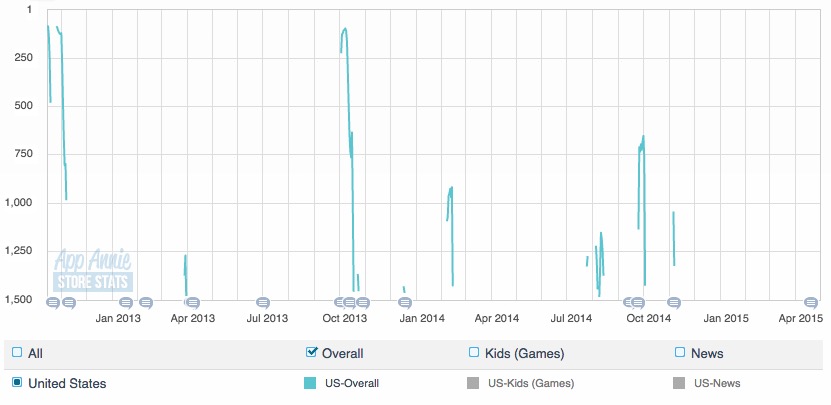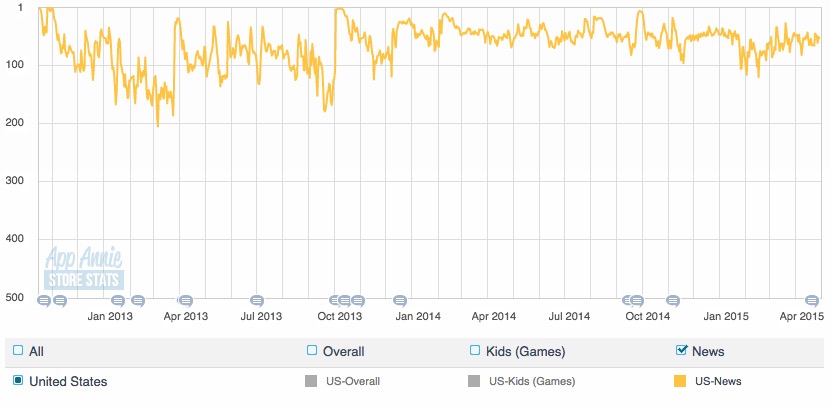
That wish will now be tested. Fortune’s Dan Primack reported yesterday evening that Circa — the mobile-first, idea-laden, atomized-content news startup that’s gotten a ton of attention in recent years — had failed to get a new round of venture funding and was now looking for a buyer:
Circa had previously raised over $5 million; late last year, Ken Doctor reported on their search for another $8 million round.“This isn’t a ‘sell the assets’ only situation,” explains [CEO Matt] Galligan, adding that Circa is working with an undisclosed third party to find a buyer. “This is an acquisition process, and we’re talking with a number of interested parties. One possibility is that we keep the brand. Another is that we apply our tech know-how to a different brand, or perhaps we integrate everything we’ve learned about the space and built so far in a way that the unique spirit of Circa lives on in another product… Our intent is to find the right partner to keep growing this idea.”
If you were to whittle down Circa to its core arguments, they might go something like this:
 The first argument is, for me, inarguable — which is why so many people in the news business have been interested in Circa. I used to get asked about them all the time, though the pace has fallen off a bit in the past year or so. The shift to mobile is a very big deal for publishers, and broadly speaking, they seem unprepared for it. Older companies are looking to baggage-free startups to come up with new approaches.
The first argument is, for me, inarguable — which is why so many people in the news business have been interested in Circa. I used to get asked about them all the time, though the pace has fallen off a bit in the past year or so. The shift to mobile is a very big deal for publishers, and broadly speaking, they seem unprepared for it. Older companies are looking to baggage-free startups to come up with new approaches.
The second argument has an obvious appeal; the traditional story form is indeed feeling creaky. But I’m skeptical that Circa-style atomization-and-reassembly is as effective a response to it as [pick one: blogging, listicles, data visualization, podcasts, email newsletters, tweets, or any of the other content formats the Internet has either created or empowered].
News UX innovation only works if you have compelling content http://t.co/uyUzKEFPsu
— Joshua Benton (@jbenton) April 30, 2015
Chopping up a story into bits risks draining all human voice from it. Think about how, say, The Economist and BuzzFeed would write up their takes on a given story. They’d be quite different, obviously, but they’d also be identifiably theirs. Circa stories are bland and sapped of personality — a CMS strategy confused with an editorial one. (For a back-and-forth Circa’s Anthony De Rosa and I had about this, including his defense of its “voiceless by design” approach, see this tweet and its replies.) Combine that with the fact that Circa did basically no original reporting — only aggregating bits and pieces from other sources — and I never felt the need to read the Circa take on anything.
Of course, that’s my response to Circa as a news consumer as much as my response as someone who writes about media innovation. My news habits are hardly normal, and a number of people whose opinions I respect do enjoy the app:
The mobile-first, mobile-forever news app, @Circa, which I use, is seeking a buyer. Having run out of money. http://t.co/yS7SKOFoi9
— Jay Rosen (@jayrosen_nyu) April 30, 2015
@jbenton Started out with the former, but lately the latter.
— Jay Rosen (@jayrosen_nyu) April 30, 2015
Rafat Ali sees Circa’s buzz as an example of media people’s navel gazing — or at least an inability to separate interesting ideas from a compelling product:
Literally *every* person on Twitter saying nice words about Circa works in media. Therein lies the start of its problems…
— Rafat Ali (@rafat) May 1, 2015
Lesson? After your 15 mins of fame are over and the media circlejerk moves on, can you build a real business?
— Rafat Ali (@rafat) April 30, 2015
There’s truth to that, but I think it’s also a little more complicated. It was less “media people” who pumped up Circa than people at the intersection of tech and media — particularly those who fly out of SFO or SJC.
It was initially the idea of Ben Huh tackling news that got attention, from places like TechCrunch, VentureBeat, The Next Web, and Gigaom. It wasn’t “media people” who were inclined to think that a so-so editorial product with an interesting tech hook would “revolutionize” (1, 2, 3) a crusty old industry. Both Circa and how people talk about Circa are far more Silicon Valley than Midtown Manhattan; traditional media companies were interested in Circa, but they weren’t the ones talking it up as a brave new paradigm of information transmission.
All of Circa’s interesting ideas (its approach to push notifications was smart) never quite congealed into an interesting product — or at least into a product appealing to as large an audience as its middle-of-the-road content would seem to require. (Not to mention its staffing model — all that chunking and rewriting took a not-insignificant number of people. Something like Summly/Yahoo News Digest promised to do something similar, but relying more heavily on algorithms. The benefit of more human involvement should have been better editorial, but Circa’s content model worked against that.)Circa consistently declined to release user data:
@jbenton While I'd love to, there's just no value in it for us. Numbers aren't as big as BuzzFeed so we'll immediately be compared.
— Matt Galligan (@mg) March 27, 2014
(At the risk of being obvious, there’s a wide range of audiences “not as big as BuzzFeed” that other people are happy to report.)
And it was not a particular hit in the App Store, either overall or in the News category:


What’ll happen next? Maybe Circa gets bought by an old media company looking to white-label it, or to build off its CMS. (Maybe Canada’s Postmedia will buy it, since it already lifted Circa’s UX for its mobile apps.) Maybe someone will buy it for the substantial talent that still works there. Or maybe it’ll just go away, and a few investors will be out about $5 million.
But whatever happens, I’ll remember Circa fondly as a pioneer in building news experiences for mobile devices — and as a reminder that technical innovation in media can only go so far without compelling editorial.